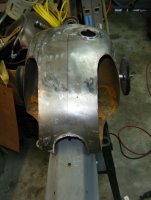I'll admit I haven't read every word of every post on every page so maybe this got addressed… but I missed it if it got discussed.
In your description of what detonation is, you left out the concept of a delay period. this gets important later so let me ramble a bit here. The mixture in the cylinder is exposed to high temp and pressure. It can only resist this temp and pressure for a given amount of time before it detonates, as in , there isn't a given combination where it explodes, there is a given amount of time for various conditions before it explodes.
A common misconception I see is people thinking that detonation occurs because the flame front moves too fast. this isn't true. Detonation is sudden, everything goes BANG rather than burns. This creates a shock wave that bounces around in the cylinder and makes the knocking noise which identifies the condition. it also knocks the boundary layer off the piston, which removes the insulating properties of the boundary layer and lets the piston heat up, which weakens it which leads to damage. There is no flame front when a cylinder detonates I used to have a text that had pictures of detonation happening. you could see the flame, then BOOM. nothing.
Which was all supposed to tie in to something I saw in another post - that high octane gas burns slower than low octane gas.
My challenge is for someone to post a technical reference, that means not Hot Rod magazine or Wikipedia, etc, that claims there is a significant difference in the flame speeds of high and low octane pump gasoline, or that flame speed is the method used to control detonation.
Here's the thing. Making the gas mixture burn slower would make detonation WORSE, not better. It goes back to the delay period. You want the mix to burn as fast. Hence all the other mods get get "more complete combustion" like dual plugs, swirl in the intake charge, MSD ignitions, that kind of stuff. It's all designed to burn the mix faster. You want to burn it all before the delay period expires and it goes boom. Why would it make sense to make the gas itself burn slower? A higher octane gasoline resists autoignition due to high temp and pressure longer than a lower octane gas does. it gives you more time to burn the mix but does not burn it slower. You want to reduce detonation? Lower the temp, lower the pressure, burn the mix FASTER, or make the gas more resistant to autoignition.
To address a few misconceptions I see (not necessarily here) Slow flame speeds do not prevent detonation, they make it worse. Fast flame speeds do not cause detonation, they reduce it. Multiple flame fronts coming together do not cause detonation.
Why should anyone believe me? No reason. So here are some sources I found earlier (and posted on another site) concerning this. Read the references, note the sources, and think about it. Make your own decisions.
*************************
I've seen this basic write up on a couple different race fuel supplier sites.
http://www.whitfieldoil.com/www/docs/171.284/vp-racing-fuel-
Another link from a fuel supplier
http://www.pinux-products.com/octane-rating/
Check out Section 6.3 of this university paper:
http://blizzard.rwic.und.edu/~nordlie/cars/gasoline.html
Sunoco Race Fuels says this:
http://www.racegas.com/article/10
Any opinion can be supported by links to internet sites. But it also makes no sense that a slower burning mixture would be better for controlling detonation. Flame fronts, even fast ones, are a controlled burn, detonation is an explosion.
*************
No flames intended here, I've just seen the slow burning gas claim so often and no one ever questions why we would do so many mods to make the mixture burn faster, then put a slow burning mixture in there.





